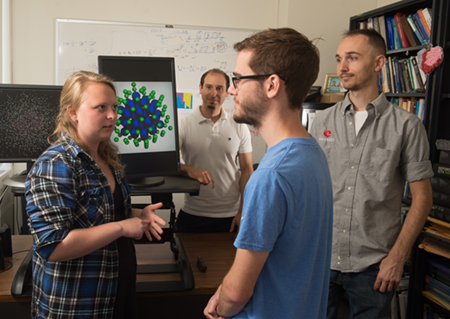 Is the whole greater than the sum of its parts? It’s a question that carries deep meaning in quantum mechanics, and one that ignites the theoretical passion of Southern Illinois University Edwardsville’s Edward Ackad, PhD, associate professor of physics in the College of Arts and Sciences.
Is the whole greater than the sum of its parts? It’s a question that carries deep meaning in quantum mechanics, and one that ignites the theoretical passion of Southern Illinois University Edwardsville’s Edward Ackad, PhD, associate professor of physics in the College of Arts and Sciences.
Ackad is principal investigator of a $566,021 grant from the Air Force Office of Scientific Research, which supports his research project, entitled “Understanding Laser Cluster Interaction in the X-ray Regime.”
The research seeks to understand how nanoscopic matter interacts with extremely intense lasers. Findings could contribute to important future developments in the fields of biophysics, biomedicine and more.
“This is basic research, as compared to applied research,” Ackad explained. “It’s not meant to give a particular result. Rather, I’m looking for new physics phenomena. I have always sought to understand the root causes of things. This research considers how nanoscopic matter behaves on its own, as well as how it behaves under extremely intense lasers, in particular, an X-ray laser.”
Ackad and his team of student researchers engage in high performance computing, using specialized graphic processing units that are common in the commercial video gaming industry.
“These specialized processors are great at taking a whole bunch of data and conducting a single operation on them incredibly fast,” Ackad said. “For calculations, these gaming tools can be extremely useful.”
The research team uses high performance compute clusters at SIUE and nationwide to do the calculations on the specialized graphic processors. They use a suite of custom built tools, many by former and current undergraduate students, to analyze the data and gain insight into the underlying physics.
“The Air Force is interested because it saw interesting phenomena going on in clusters in the infrared, and wondered, what’s going to happen in an X-ray regime or with an X-ray laser,” added Ackad. “We’re the only theoretical group working on this basic research in the U.S.”
This exploratory, hands-on project offers physics students the opportunity to participate in research early in their academic career. The research topic, combined with Ackad’s mentorship, has inspired numerous students interested in the field.
“I came to SIUE to study an unrelated field, but I switched to physics after an introductory course with Dr. Ackad,” said Kasey Barrington, of Springfield. “My love for physics was rekindled, because it offers what I want most—a solid education that enriches my life.”
Barrington has written programs to process and analyze data from simulations, as well as mentored new students as they have joined the project.
“Prior to my work on this project, I thought the most important aspect of science was gathering information from experiments and publishing those results,” Barrington added. “After seeing for myself that two experts in a field can look at the same information and come to two different conclusions, I now understand the most important aspect of science is the dialogue in the community after the work has been published.”
Fellow student Valerie Becker, of Staunton, has also contributed to the research, which aligns with her lifelong desire to know how and why the world works as it does.
“Physics is the way I understand the world and how these different parts of everyday life work,” Becker said. “Experiencing different research environments and areas of physics has helped me develop my own professional skills, preferences as a researcher and identity as a physicist.
For those not accustomed to physics speak, Becker says she loves to explain the team’s work and get others excited about physics.
“We simulate shooting lasers at small balls of gas and watch them blow up!” she explained with energy. “One of the most important factors in doing science is being able to understand and communicate nuanced phenomenon effectively.”
“In working with students, I hope to pass along a passion for physics through an engaging form of teaching such as research,” Ackad said. “Students learn faster, because it’s directed learning. When you give students a research goal, it’s astonishing to watch them leap over any hurdle or mountain that is put in front of them. They are incredibly motivated.”
Photo: Edward Ackad, PhD, (back) associate professor of physics at SIUE, observes as student researchers discuss their project, including (L-R) Valerie Becker, Jeremy Thurston, and Kasey Barrington.